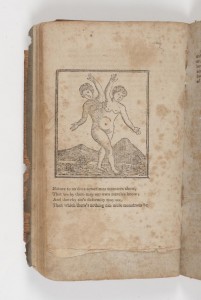Aristotle’s Master-piece, Completed. In Two Parts.The First Containing the Secrets of Generation… The Second Part being a Private Looking-Glass for the Female Sex. New-York: Printed for the Company of Flying Stationers, 1812.
 Aristotle’s Masterpiece is a fascinating hybrid text. It used the veneer of a supposed classical author (Aristotle really had about as much to do with this work as the Pope did) in order to give legitimacy to its discussion of the culturally sensitive subject of sex. Printed under various titles for over a century in America (from the 1740s-1840s), sections were added, dropped, and changed at will, including a midwifery manual. Most notable in almost all editions are the illustrations of monstrous births, hairy women, conjoined twins, etc.
Aristotle’s Masterpiece is a fascinating hybrid text. It used the veneer of a supposed classical author (Aristotle really had about as much to do with this work as the Pope did) in order to give legitimacy to its discussion of the culturally sensitive subject of sex. Printed under various titles for over a century in America (from the 1740s-1840s), sections were added, dropped, and changed at will, including a midwifery manual. Most notable in almost all editions are the illustrations of monstrous births, hairy women, conjoined twins, etc.
This 1812 edition is unrecorded, but about a dozen among the more than fifty editions of Aristotle’s Masterpiece at AAS bear the imprint “for the company of flying stationers.” Flying stationers were book chapmen who, alongside broadside and ballad pedlars, hawked their wares on the street. Elsewhere in AAS’s collections, an almanac for 1761 was described as “sold also by the country storekeepers, moving-merchants, flying stationers and old ballad-women.” This early sex manual would have had a similar street-level distribution system, although perhaps it was advertised more through tantalizing whispers than the usual street cries?
